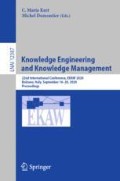Abstract
Knowledge Graphs (KGs) model statements as head-relation-tail triples. Intrinsically, KGs are assumed incomplete especially when knowledge is represented under the Open World Assumption. The problem of KG completeness aims at identifying missing values. While some approaches focus on predicting relations between pairs of known nodes in a graph, other solutions have studied the problem of predicting missing entity properties or relations even in the presence of unknown tails. In this work, we address the latter research problem: for a given head entity in a KG, obtain the set of relations which are missing for the entity. To tackle this problem, we present an approach that mines latent information about head entities and their relations in KGs. Our solution combines in a novel way, state-of-the-art techniques from association rule learning and community detection to discover latent groups of relations in KGs. These latent groups are used for predicting missing relations of head entities in a KG. Our results on ten KGs show that our approach is complementary state-of-the-art solutions.
Access this chapter
Tax calculation will be finalised at checkout
Purchases are for personal use only
Notes
- 1.
These are DBpedia- and Wikipedia-specific relations to denote information about the Wikipedia page and the class of an entity, respectively.
References
Acosta, M., Simperl, E., Flöck, F., Vidal, M.: Enhancing answer completeness of SPARQL queries via crowdsourcing. J. Web Semant. 45, 41–62 (2017)
Agrawal, R., Srikant, R.: Fast algorithms for mining association rules in large databases. In: Proceedings of VLDB 1994, pp. 487–499. Morgan Kaufmann Publishers Inc. (1994)
Auer, S., Bizer, C., Kobilarov, G., Lehmann, J., Cyganiak, R., Ives, Z.: DBpedia: a nucleus for a web of open data. In: Aberer, K., et al. (eds.) ASWC/ISWC -2007. LNCS, vol. 4825, pp. 722–735. Springer, Heidelberg (2007). https://doi.org/10.1007/978-3-540-76298-0_52
Bollacker, K., Evans, C., Paritosh, P., Sturge, T., Taylor, J.: Freebase: a collaboratively created graph database for structuring human knowledge. In: Proceedings of ACM SIGMOD, pp. 1247–1250. ACM (2008)
Bordes, A., Usunier, N., Garcia-Durán, A., Weston, J., Yakhnenko, O.: Translating embeddings for modeling multi-relational data. In: Proceedings of NIPS, pp. 2787–2795 (2013)
Clauset, A., Newman, M.E.J., Moore, C.: Finding community structure in very large networks. Phys. Rev. E 70, 066111 (2004)
Fournier-Viger, P., Wu, C.-W., Zida, S., Tseng, V.S.: FHM: faster high-utility itemset mining using estimated utility co-occurrence pruning. In: Andreasen, T., Christiansen, H., Cubero, J.-C., Raś, Z.W. (eds.) ISMIS 2014. LNCS (LNAI), vol. 8502, pp. 83–92. Springer, Cham (2014). https://doi.org/10.1007/978-3-319-08326-1_9
Galárraga, L.A., Teflioudi, C., Hose, K., Suchanek, F.: Amie: association rule mining under incomplete evidence in ontological knowledge bases. In: Proceedings of WWW, pp. 413–422. ACM (2013)
Liu, Y., Liao, W.k., Choudhary, A.: A fast high utility itemsets mining algorithm. In: Proceedings of UBDM 2005, pp. 90–99. ACM (2005)
Mihindukulasooriya, N., Rashid, M.R.A., Rizzo, G., García-Castro, R., Corcho, O., Torchiano, M.: RDF shape induction using knowledge base profiling. In: Proceedings of ACM SAC (SAC 2018), pp. 1952–1959. Association for Computing Machinery, New York (2018)
Miller, G.A.: WordNet: a lexical database for english. Commun. ACM 38(11), 39–41 (1995)
Newman, M.E.J.: The structure of scientific collaboration networks. Proc. Nat. Acad. Sci. 98(2), 404–409 (2001)
Omiecinski, E.R.: Alternative interest measures for mining associations in databases. IEEE TKDE 15(1), 57–69 (2003)
Pellissier Tanon, T., Stepanova, D., Razniewski, S., Mirza, P., Weikum, G.: Completeness-aware rule learning from knowledge graphs. In: d’Amato, C., et al. (eds.) ISWC 2017. LNCS, vol. 10587, pp. 507–525. Springer, Cham (2017). https://doi.org/10.1007/978-3-319-68288-4_30
Pons, P., Latapy, M.: Computing communities in large networks using random walks. In: Yolum, I., Güngör, T., Gürgen, F., Özturan, C. (eds.) ISCIS 2005. LNCS, vol. 3733, pp. 284–293. Springer, Heidelberg (2005). https://doi.org/10.1007/11569596_31
Raghavan, U.N., Albert, R., Kumara, S.: Near linear time algorithm to detect community structures in large-scale networks. Phys. Rev. E 76, 036106 (2007)
Rebhi, W., Yahia, N.B., Ben Saoud, N.B.: Hybrid modeling approach for contextualized community detection in multilayer social network. Procedia Comput. Sci. 112(C), 673–682 (2017)
Tran, M.D., d’Amato, C., Nguyen, B.T., Tettamanzi, A.G.B.: An evolutionary algorithm for discovering multi-relational association rules in the semantic web. In: Proceedings of GECCO (GECCO 2017), pp. 513–520. ACM, New York (2017)
Trouillon, T., Welbl, J., Riedel, S., Gaussier, E., Bouchard, G.: Complex embeddings for simple link prediction. In: Proceedings of ICML, pp. 2071–2080. JMLR.org (2016)
Vrandečić, D., Krötzsch, M.: Wikidata: a free collaborative knowledgebase. Commun. ACM 57(10), 78–85 (2014)
Author information
Authors and Affiliations
Corresponding author
Editor information
Editors and Affiliations
Rights and permissions
Copyright information
© 2020 Springer Nature Switzerland AG
About this paper
Cite this paper
Weller, T., Dillig, T., Acosta, M., Sure-Vetter, Y. (2020). Mining Latent Features of Knowledge Graphs for Predicting Missing Relations. In: Keet, C.M., Dumontier, M. (eds) Knowledge Engineering and Knowledge Management. EKAW 2020. Lecture Notes in Computer Science(), vol 12387. Springer, Cham. https://doi.org/10.1007/978-3-030-61244-3_11
Download citation
DOI: https://doi.org/10.1007/978-3-030-61244-3_11
Published:
Publisher Name: Springer, Cham
Print ISBN: 978-3-030-61243-6
Online ISBN: 978-3-030-61244-3
eBook Packages: Computer ScienceComputer Science (R0)

